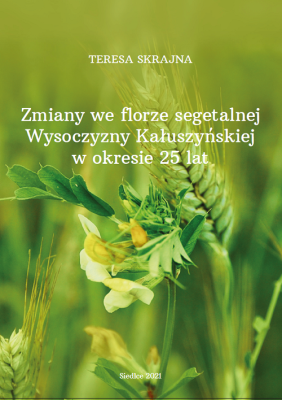Changes in segetal flora of the Kałuszyn Upland over a period of 25 years
Synopsis
Segetal flora is subject to constant anthropogenic pressure. The intensification of the production processes has led to the disappearance of the most vulnerable flora species and the simultaneous spread of plants with a wide ecological amplitude. Habitat transformations and changes in the use of arable land have affected the composition of phytocenoses, and species with a narrow ecological amplitude occur less often.
The aim of the study was to analyze the changes taking place in the flora of field agrocenoses of the Kałuszyn Upland between 1994 and 2021. The observations were carried out in two research periods (1994-1996 and 2019-2021). In both periods, a total of 1343 phytosociological relevés were taken, 857 in the first period and 486 in the other. They were used to analyze segetal flora transformations taking place over the last 25 years. The floristic similarity was determined, and a detailed analysis of the flora in both research periods was carried out. After determining the dynamics of occurrence of the species and a degree of their stability, groups of spreading and receding species and those with balanced dynamics were separated. In the group of spreading species, expansive species were selected.
The studied area was the southernmost part of the South Podlasie Lowland. It is an agricultural mesoregion of a significant natural value. The diverse mosaic landscape is rich in numerous marginal habitats, which indirectly affect the preservation of the large floristic biodiversity of field agrocenoses. A distinctive feature of the segetal flora of the area is a large share of apophytes.
During the study period, there was a decrease in the number of native species of flora accompanied by slight changes in the group of species of alien origin. The depletion of native flora was marked by a lower number of species in a given crop field and in a phytosociological relevé. The share of rare and endangered species is an indicator of species richness. In the second period, the disappearance or reduction of the number of sites with some species was observed.
The analysis of the segetal flora of Kałuszyn Upland agrocenoses showed a large decrease in the number of species and an intensification of the occurrence of species with a wide ecological amplitude. Highly spreading species included Echinichloa crusgalli, Setaria pumila, Setaria viridis and Avena fatua, whose share increased greatly during the period. The increased occurrence of Polygo-num lapathifolium ssp. palidum is also noteworthy, especially in winter cereals, with Lapsana communis found in spring cereals, Galinsoga parviflora and Euphorbia helioscopia in root crops and Amaranthus retroflexus in stubble fields. The species that had spread through most crops was Veronica persica. It was found in principle in all habitats, but on poor soils it was less common. Its occurrence among root crops and stubble fields was particularly frequent. Changes in the segetal flora of the area were large, and a characteristic feature of the transformations was species unification, with their decreasing number. They often formed patches dominated by one or two species. A consequence of these changes was a decrease in biodiversity, which in these heavily transformed agrocenoses reached the lowest values.
Downloads

Downloads
Published
License

This work is licensed under a Creative Commons Attribution-NonCommercial 4.0 International License.




